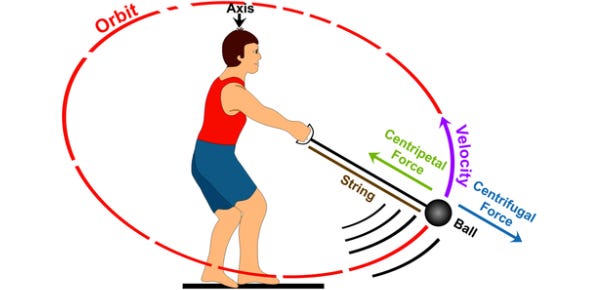Centrifugal Forces and the Role of Circular Motions
Written by Fiona Nikolla
In the field of physics, it is truly captivating how the state of objects and conditions relative to an object in motion play a crucial role in understanding force. Whether it is a vertical, horizontal, or a circular force that will be later elaborated on, it all revolves around the basic understanding of how it comes and interacts with other factors in a scenario or environment.
The Importance of Inertia
The concept of inertia is important in understanding why a centrifugal force is often characterized as an untraditional force. Inertia is known for an object’s ability to resist or go against a change in its current condition of motion. This causes anything that is a part of a centrifugal force to want to remain in a straight motion perpendicular to the already produced circular path created. This is important in understanding the concept of this force because it tends to either cause an object to pull or push towards the ultimate middle of the rotation occurrence.
Non-Traditional Concept of a Force
What sets apart centrifugal forces from other conventional ones is its ability to not need any previous physical interface to create the initial start of the force. Unlike the concept of inertia that states an object must remain in motion unless another opposing force acts upon it otherwise, a centrifugal force is something that remains instantaneous as the circular and linear forces continue to act perpendicularly to each other. This is what creates the ultimate feeling that an object, or person when experiencing this force, may feel a sense of outward pushing in participating in a rapidly circular motion. In the sense of laboratory studies, centrifuges are machines that are known to use this circular force to separate different substances depending on their densities. It can further be applicable in the understanding of motion fast moving objects such as cars or rollercoasters since this can help stabilize the effect of turns in the dynamics of these fast-paced vehicles.
Centripetal vs. Centrifugal
Though both these forces start with a common prefix of -centri, deriving from the term center, both forces are different in their conduction of motion and process. For a centripetal force to occur, it requires an additional outside action whether it be friction or gravitational pull that can allow for an object to continue a circular path. As previously mentioned, and elaborated, this differs from a centrifugal force because it occurs with any form of interaction; rather, it only can happen with the effect of inertia and its frame of rotating reference. More so, centripetal forces are observed in a non-rotating frame of orientation.
When in a turning car or rapidly spinning roller coaster, be sure to realize the effect of such motions as they create such an outward, pushed feeling initiated with the presence of a centrifugal force. As these forces seem small, immaculate, and not as present in daily life, it is important to realize how they affect the field of motion and relativity to other crucial movements present in everyday actions.
References
https://sciencenotes.org/centrifugal-force-definition-formula-examples/#google_vignette
Written by Fiona Nikolla from MEDILOQUY


